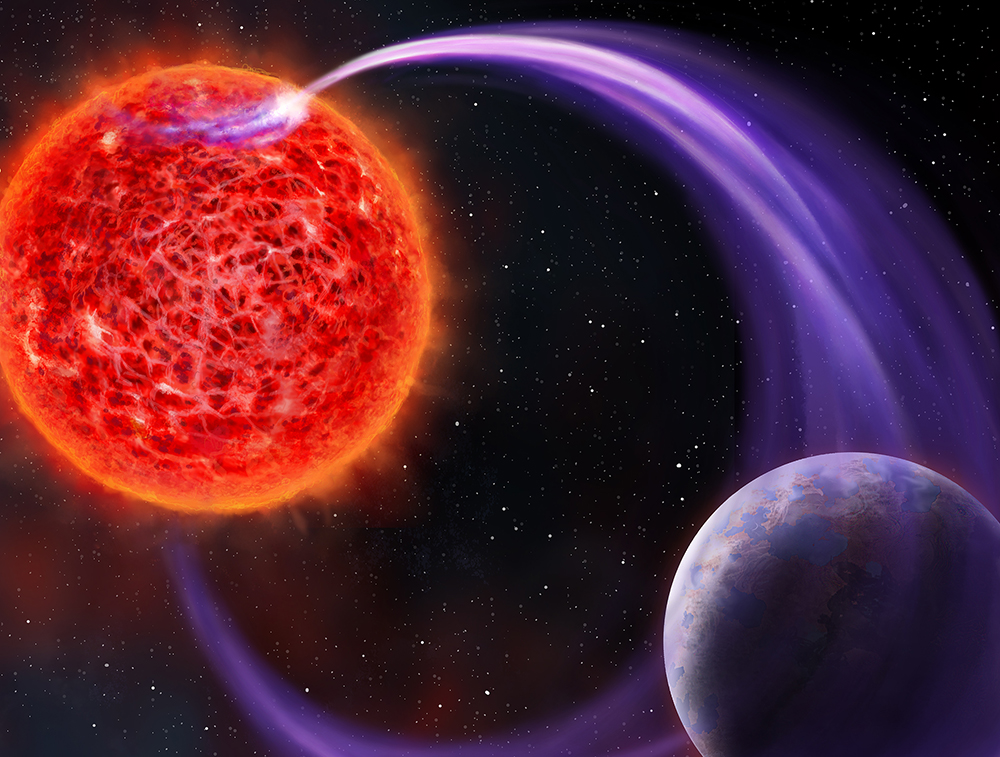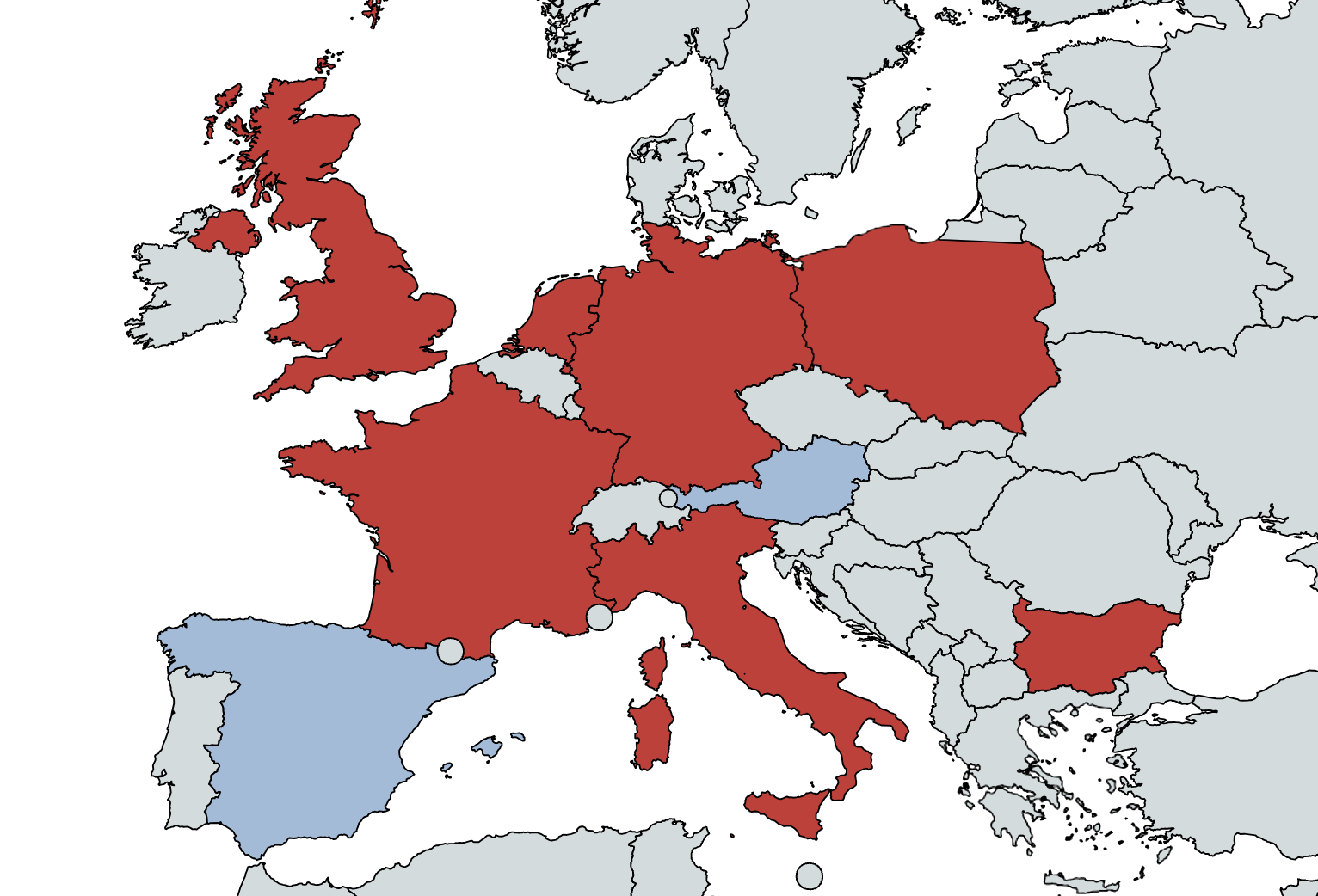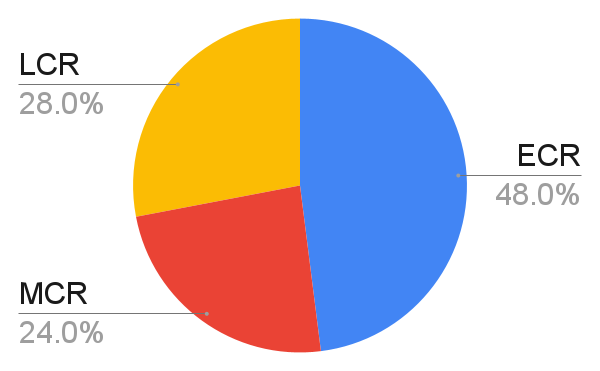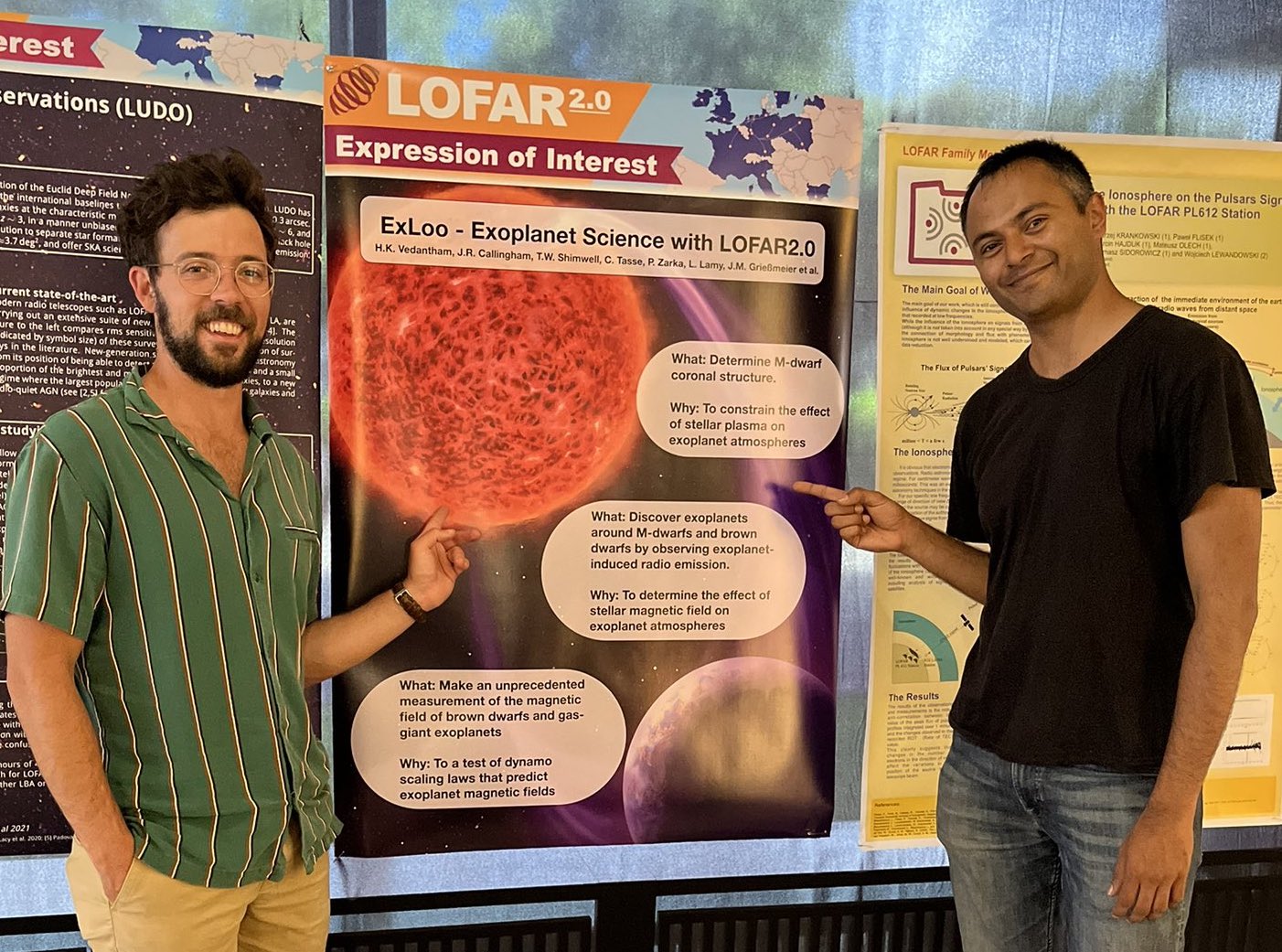What we want to do

The low radio frequency skycarries unique information on the plasma environment and magnetic fields of exoplanets, brown dwarfs, and stars. Radio observations also probe magnetic interactions between exoplanets and their host stars (star--planet interaction) which, in addition to being a novel exoplanet characterisation and discovery technique, determines the rate of exoplanet atmospheric heating and stripping.
Using the unparalleled sensitivity of LOFAR1.0, our group has opened up this low frequency window to stellar and exoplanet science. We have discovered the underlying radio population of suspected star--planet interaction candidates, the coldest brown dwarfs (massive cousins of exoplanets), and found tentative evidence for radio emission from an exoplanet. In this process we have also built a team with modelling and multi-wavelength expertise that has a multiplicative effect on the scientific value of LOFAR data.
With the ExLOO survey we propose to exploit the sensitivity and bandwidth capabilities of the LOFAR2.0 upgrade to (a) test magnetic dynamo scaling laws in the exoplanet field-strength regime, (b) determine the effect of stellar coronal plasma, particularly magnetic star--planet interaction, on exoplanet atmospheres and (c) achieve a direct detection of radio emission from a gas-giant exoplanet for the first time. We plan to achieve these ambitious goals using 1700 effective hours (5400 hr of on-target exposure) of LOFAR2.0 observations on 40 targets comprising red-dwarf stars, brown dwarfs, and exoplanets. In doing so, we intend to serve the larger LOFAR community by collaboratively developing software tools for polarimetric calibration/analysis and deep integration down to 20 MHz.
The Dream Team
List of members of the ExLOO survey proposal and their affliations, in no particular order.
| Harish Vedantham | ASTRON / Groningen University |
| Joe Callingham | ASTRON / Leiden University |
| Aline Vidotto | Leiden University |
| Robert Kavangh | ASTRON |
| Sanne Bloot | ASTRON |
| Manuel Güdel | Universität Wien |
| William M J Best | University of Texas at Austin |
| Trent Dupuy | University of Edinburgh |
| Timothy Shimwell | ASTRON |
| Antonia Rowlinson | University of Amsterdam / ASTRON |
| Julien Morin | Laboratoire Univers et Particules de Montpellier |
| Paul Robertson | University of California Irvine |
| Miguel Pérez-Torres | Instituto de Astrofísica de Andalucía (IAA-CSIC), Granada |
| Jean-Mathias Grießmeier | LPC2E |
| Laurent Lamy | LESIA, Obs. Paris/PSL, CNRS et LAM, Aix-Marseille Univ/Pythéas, CNES |
| Benjamin Pope | University of Queensland; University of Southern Queensland |
| Kristo Ment | Penn State |
| Megan Delamer | Penn State |
| Ekaterina Ilin | ASTRON |
| Maximilian N. Günther | European Space Agency (ESA) |
| David Charbonneau | Harvard University |
| Jennifer Winters | Harvard University |
| Suvrath Mahadevan | Penn State |
| Evan Fitzmaurice | Penn State |
| Elizabeth Gonzales | Penn State |
| Trent Dupuy | University of Edinburgh |
| Gudmundur Stefansson | University of Amsterdam |
| Philippe Zarka | Observatoire de Paris (LESIA & ORN), CNRS, PSL |
| Joachim Saur | University of Cologne |
| Jonathan Nichols | University of Leicester |
| Xiang Zhang | LESIA, Observatorie de Paris |
| Corentin K. Louis | LESIA, Observatoire de Paris, CNRS |
| Quentin Duchêne | LESIA, Observatoire de Paris |
| Julien N. Girard | LESIA, Observatoire de Paris |
| David Konijn | ASTRON |
| Timothy Yiu | ASTRON |
| Cristina Cordun | ASTRON |
| Luis Peña-Moñino | IAA-CSIC, Granada |
| Javier Moldón | IAA-CSIC, Granada |
| Alex Drabent | TLS |
| Ansgar Reiners | University of Göttingen |
| Simranpreet Kaur | CSIC |
| Daniele Viganò | CSIC |
| Marcin Hadjuk | UWM |
| Jake Turner | Cornell University |
| Paolo Leto | INAF |
| Jonathan Irwin | Harvard University |
| Corrado Trigilio | INAF |
| Grazia Umana | INAF |
| Ignas Snellen | Leiden University |
| Jean-Michel Désert | University of Amsterdam |
| Reinout van Weeren | Leiden University |
| Francesco de Gasperin | INAF |
| Antoaneta Antonova | Bulgarian Academy of Sciences |
| Jose Caballero | CAB-INTA, CSIC |
Demographics
In order to tackle the scientific challenges of the ExLOO proposal, we have formed a specialist team that is diverse geographically, technically, and in career-stage. Our research team is composed of experts that cover the electromagnatic spectrum and key theoretical areas of stellar and exoplanetary science.
We have team members from seven of the ten ILT countries, as shown in the figure below. Demonstrating that our survey is maximising reach and inclusivity, we also have domain experts from numerous non-ILT countries such as Spain, Austria, Australia, and the USA. In turn, these non-ILT collaborators facilitate integration into key observing programs and consortia usually not available to ILT members, such as HPF and CARMENES.
 Geographic distribution of collaborators associated with ExLOO. Red represents members of the proposal from ILT countries, while blue represents members from countries not formally part of the ILT. We have CIs locared at 70% of ILT countries. We also have active collaborators in Australia and the USA.
Geographic distribution of collaborators associated with ExLOO. Red represents members of the proposal from ILT countries, while blue represents members from countries not formally part of the ILT. We have CIs locared at 70% of ILT countries. We also have active collaborators in Australia and the USA.
The career diversity of our team is also evenly balanced between early- (<7 years since PhD), mid- (<20 years since PhD), and late- (>20 years since PhD) career researchers, as shown in the figure below.
 Distribution of early- (<7 years since PhD), mid- (<20 years since PhD), and late- (>20 years since PhD) career researchers in the survey team. Note we have not included PhD students in this plot
Distribution of early- (<7 years since PhD), mid- (<20 years since PhD), and late- (>20 years since PhD) career researchers in the survey team. Note we have not included PhD students in this plot
Despite our success in achieving a healthy team diversity in expertise, career, and geography, our gender diversity is unsatisfactory (~20% woman-identifying representation). While we have women in key positions of leadership in the survey, we recognise the need to increase the number of women contributing to the survey. We are well placed to address this since the exoplanet field is known to be a more gender diverse than other parts of astronomy. As our impact on the exoplanet field will grow with time, we expect to be able to attract that talent. We will implement a mentor program that will encourage women ECRs to take leadership roles in the survey. We will also facilitate online sub-conscious bias training for our team to ensure the environment of our team is welcome to all backgrounds.
Policies
To make a successful and well functioning team, polcies on membership, projects, and publications have to be clearly defined. You can find drafts of our policies here: https://tinyurl.com/exloopolicy.
All members of the ExLOO survey team will abide by the following Code of Conduct:
The ExLOO survey is dedicated to providing an inclusive, equitable, supportive, and safe environment for members and collaborators. We value, respect, and aim to accommodate all members of our community and the diversity of their identities including gender, gender expression, sexual orientation, disability, physical appearance, cultural background, age, nationality, family status, opinion or religion.
We behave with respect and compassion, and we are kind to others. All our communication, written, verbal and non-verbal should be appropriate for a professional audience including people of all different backgrounds. We do not insult or put down anyone. We do not tolerate any discriminative or exclusionary communication, behaviour or harassment in any form. All members are required to act with academic integrity in their research.
Many situations related to the code of conduct can be solved immediately by a respectful discussion. In other cases the situation can be reported by contacting either the PIs or a member of the ExLOO advisory board. The parties involved will be heard on the shortest possible notice. Based on the outcome of the investigation, further actions may be taken.
contact

If you need more information, or want to join the team. Please reach out to the Principal Investigators:
Dr Joseph Callingham
callingham@astron.nl
Elements
Text
This is bold and this is strong. This is italic and this is emphasized.
This is superscript text and this is subscript text.
This is underlined and this is code: for (;;) { ... }. Finally, this is a link.
Heading Level 2
Heading Level 3
Heading Level 4
Heading Level 5
Heading Level 6
Blockquote
Fringilla nisl. Donec accumsan interdum nisi, quis tincidunt felis sagittis eget tempus euismod. Vestibulum ante ipsum primis in faucibus vestibulum. Blandit adipiscing eu felis iaculis volutpat ac adipiscing accumsan faucibus. Vestibulum ante ipsum primis in faucibus lorem ipsum dolor sit amet nullam adipiscing eu felis.
Preformatted
i = 0;
while (!deck.isInOrder()) {
print 'Iteration ' + i;
deck.shuffle();
i++;
}
print 'It took ' + i + ' iterations to sort the deck.';
Lists
Unordered
- Dolor pulvinar etiam.
- Sagittis adipiscing.
- Felis enim feugiat.
Alternate
- Dolor pulvinar etiam.
- Sagittis adipiscing.
- Felis enim feugiat.
Ordered
- Dolor pulvinar etiam.
- Etiam vel felis viverra.
- Felis enim feugiat.
- Dolor pulvinar etiam.
- Etiam vel felis lorem.
- Felis enim et feugiat.
Icons
Actions
Table
Default
| Name |
Description |
Price |
| Item One |
Ante turpis integer aliquet porttitor. |
29.99 |
| Item Two |
Vis ac commodo adipiscing arcu aliquet. |
19.99 |
| Item Three |
Morbi faucibus arcu accumsan lorem. |
29.99 |
| Item Four |
Vitae integer tempus condimentum. |
19.99 |
| Item Five |
Ante turpis integer aliquet porttitor. |
29.99 |
|
100.00 |
Alternate
| Name |
Description |
Price |
| Item One |
Ante turpis integer aliquet porttitor. |
29.99 |
| Item Two |
Vis ac commodo adipiscing arcu aliquet. |
19.99 |
| Item Three |
Morbi faucibus arcu accumsan lorem. |
29.99 |
| Item Four |
Vitae integer tempus condimentum. |
19.99 |
| Item Five |
Ante turpis integer aliquet porttitor. |
29.99 |
|
100.00 |



